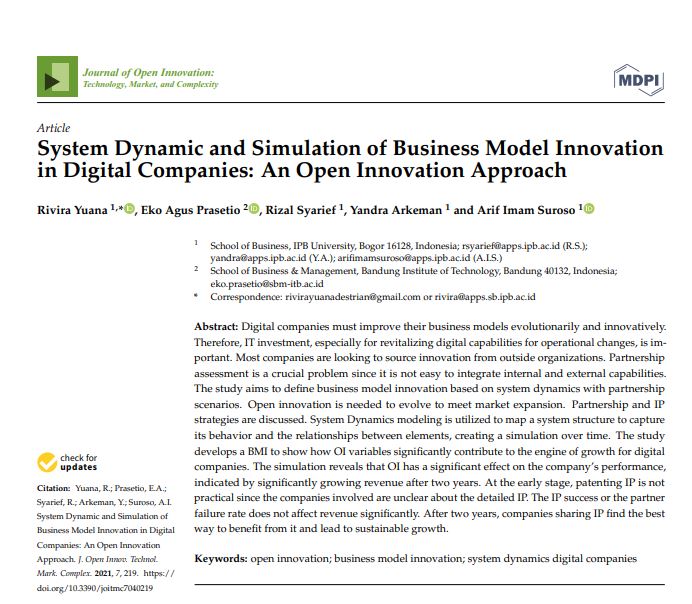
The COVID-19 pandemic has pushed digital startups to find strategies to survive and grow, especially in the early stages of their growth. One thing that is a special requirement for them is digital capabilities, where during limited resources, they are required to maintain these key capabilities. One strategy they can then implement is a partnership with an external organization or entity. This strategy is claimed to be able to help crisis management, especially during a pandemic.
This strategy is an open innovation paradigm where digital startups can reduce the cost of expensive digital transformation demands. This demand allows them to collaborate with existing partners and other parties such as universities, think tanks, consultants, crowdsourcing platforms, startups, and innovation labs.
The absence of previous studies that explain how digital companies’ partnerships at an early stage using the system dynamics approach prompted Rivina Yuana to conduct this research. Yuana is an IPB University doctoral student. She collaborated with the SBM-ITB lecturer and researcher, Eko Agus Prasetio, who became her third supervisor. System dynamics is a computational method that can improve knowledge management and decision-making during business model innovation.

This study develops a Business Model Innovation (BMI) to demonstrate how Open Innovation (OI) variables significantly contribute to the growth engine for digital companies. The results of this research were successfully published in the Journal of Open Innovation: Technology, Market, and Complexity entitled “System Dynamic and Simulation of Business Model Innovation in Digital Companies: An Open Innovation Approach.” This paper is part of Yuana’s dissertation research outputs.
BMI in Open Innovation Approach
The Business Model (BM) describes how a company makes money, including operational planning, financial and human resource processes, risk management, and internal operating mechanisms. Meanwhile, Business Model Innovation (BMI) requires modification of the business model structure. BMI refers to the search for new business logic and new approaches to generate and capture value for the company’s stakeholders. While dynamics capabilities refer to a company’s limited ability to shape, reshape, configure, and rearrange all its assets in response to changing environments, such as technology and markets. In a complex and evolving world, dynamic capabilities help organizations overcome rigid cores and increase BMI.
Open Innovation in basic concept means how companies and businesses should be more flexible and open to the innovation process. In contrast to closed innovation, researchers collect knowledge in silos. Figure 2 shows that the OI paradigm has pushed them to play a new role in moving experiences in and out of silos.

As an illustration, a company with proprietary knowledge will either go through an existing market or use shareable knowledge from partners. Proprietary knowledge can also join forces with partners that generate shareable knowledge and create new markets. Another possibility is that combining existing and shareable knowledge will result in new products with various partners.
System Dynamics Simulation Results
The literature found that Open Innovation factors consist of co-creation, IP-sharing, and Risk-sharing. Next, determine the determining factors and design a Causal Loop Diagram (CLD) model with experts, validated from their companies’ experiences. The case studies of this research are four digital startups, with details in Figure 3. Next, a mathematical model is built, and system dynamics simulation is carried out with Vensim PLE X64. Modeling System Dynamics is used to map a system structure to see its behavior and the relationships between elements, creating a simulation over time.
The simulation shows that Open Innovation (OI) significantly impacts company performance, indicated by substantially growing revenue after two years. Digital startups choose OI collaboration from the early stages to share risk and IP with other parties. More parties involved; less capital investment required. OI is implemented in the company’s strategy by collaborating with customers and suppliers. OI implementation accelerates the platform ecosystem by driving collaborative network effects to achieve sustainable growth.

The simulation shows that OI has a significant effect on the company’s performance, indicated by the substantial growth in revenue. Startups that adopt OI will bring faster product development and greater access to the market. OI’s strategy resulted in considerable revenue growth over time.
External Intellectual Property (IP) usually solves some customer problems in the beginning. After a few years, many companies or startups will duplicate it. Meanwhile, the success of the partnership will depend on IP differentiation from the company’s core business. A joint rate is a corporate action to become an active IP buyer or seller. Strategic partnerships will directly impact the company’s revenue, even though It can take several years to find the right partner.

Conclusion
This study develops a BMI to demonstrate how the variable Open Innovation (OI) significantly contributes to the growth engine for digital companies. Simulations show two years to reach a steady-state for logical IP success. In the early stages, patenting Intellectual Property (IP) is not practical because the companies involved are unclear about the detailed IP. Therefore, the IP success rate or the partner failure rate does not affect revenue significantly. Only after two years will IP-sharing companies find the best way to benefit from it, leading to sustainable growth.
During a pandemic like now, digital startups will be better off operating by forming an OI ecosystem and collaborative network. The more startups involved, the better the growth of the network. They must strengthen their dynamic ability to integrate OI into their business model.

